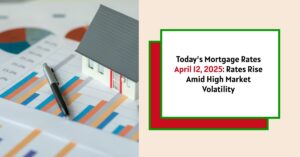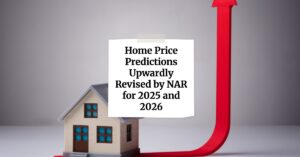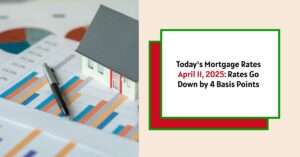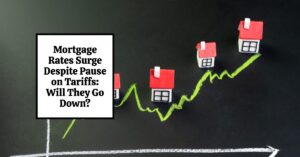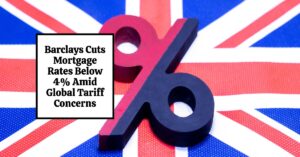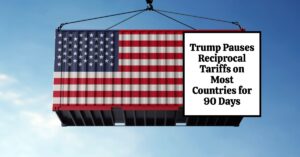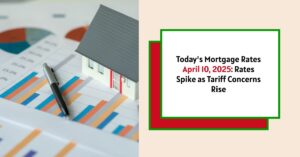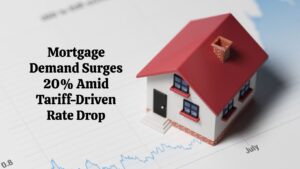As of April 12, 2025, mortgage rates have seen a noticeable increase, reflecting the current volatility in the market. The 30-year fixed mortgage rate rose to 6.90%, while the 15-year fixed rate is now 6.21%. This rise in rates emphasizes the importance of careful lender selection for potential homebuyers and those looking to refinance.
Today's Mortgage Rates – April 12, 2025: Rates Rise Amid Market Volatility
Key Takeaways
- Mortgage Rates Increased: As of April 12, 2025, the 30-year fixed rate stands at 6.90%.
- Refinance Rates Rise: The 30-year refinance rate is now 6.91%.
- Volatile Market: Rates bounced up and down this week, showcasing market unpredictability.
- Shopping for Lenders is Crucial: It is advisable to compare multiple lenders to find the best deal.
Current Mortgage Rates
Understanding the current mortgage rates is vital for homebuyers and homeowners looking to refinance. Here are the latest rates as reported by Zillow:
| Mortgage Product | Current Rate |
|---|---|
| 30-Year Fixed | 6.90% |
| 20-Year Fixed | 6.75% |
| 15-Year Fixed | 6.21% |
| 5/1 ARM | 7.24% |
| 7/1 ARM | 7.38% |
| 30-Year VA | 6.46% |
| 15-Year VA | 6.01% |
| 5/1 VA | 6.25% |
These figures represent national averages and are rounded to the nearest hundredth.
Today's Mortgage Refinance Rates
The same caution applies to those considering refinancing their existing mortgage:
| Refinance Product | Current Rate |
|---|---|
| 30-Year Fixed | 6.91% |
| 20-Year Fixed | 6.66% |
| 15-Year Fixed | 6.27% |
| 5/1 ARM | 6.86% |
| 7/1 ARM | 7.27% |
| 30-Year VA | 6.62% |
| 15-Year VA | 6.26% |
| 5/1 VA | 6.34% |
As with purchase rates, refinance rates are also subject to significant variation, and vigilance is key to finding the lowest viable option.
Understanding the Rate Changes
Mortgage interest rates have fluctuated throughout the week, causing uncertainty for buyers and homeowners alike. Rates spiked for two days, then saw a slight drop only to rise again today. This erratic behavior makes it essential for those in the market to act quickly yet prudently.
The Federal Reserve's decisions greatly influence mortgage rates, especially recent shifts in the federal funds rate intended to combat inflation. Although mortgage rates don’t mirror the federal rates directly, they often move in correlation with market expectations surrounding these changes. The expectation is that rates will not plummet this year but might stabilize around 6.0% due to ongoing economic conditions.
Fixed vs. Adjustable Rates
When considering mortgage options, many face the choice between fixed-rate and adjustable-rate mortgages (ARMs). Each has its advantages and disadvantages that can influence long-term financial health.
Fixed-Rate Mortgages
Pros:
- Consistency: Monthly payments remain stable throughout the life of the loan, which allows for easier budgeting.
- Long-Term Security: Buyers are protected from rising interest rates over time.
Cons:
- Higher Initial Rates: Fixed rates are generally higher than initial rates of ARMs, meaning potential higher monthly payments in the early years.
Adjustable-Rate Mortgages (ARMs)
Pros:
- Lower Initial Rates: ARMs typically begin with lower rates compared to fixed options, leading to lower initial monthly payments.
- Possibly Lower Total Interest Cost: If managed properly, ARMs can save borrowers money if they move or refinance before the rate adjusts.
Cons:
- Uncertain Future Payments: After the initial period, rates may increase, leading to significantly larger monthly payments that can strain budgets.
- Market Dependency: Borrowers must be comfortable with market fluctuations affecting rates and payments.
Economic Influences on Mortgage Rates
The interplay between the economy and mortgage rates remains a focal point for investors and potential homebuyers. Recent measures by the Federal Reserve aimed to control inflation have led to financial uncertainty. Inflation continues to be a concern, hovering above the central bank's target of 2%.
Expectations are that mortgage rates might trend lower in the upcoming years depending on economic conditions. If we enter a recessionary period, rates may decrease further. However, if inflation surges due to tariffs and other external economic pressures, rates could rise instead.
Housing Market Conditions
The current housing market shows a complex relationship between prices and mortgage rates. Despite rising mortgage costs, home prices are not expected to drop significantly in the near future. Supply issues mean fewer homes are available for sale, putting an upward pressure on home prices. According to Fannie Mae, home prices may increase by 3.5% in 2025.
Given these dynamics, potential homebuyers should be prepared for competitive bidding situations. The combination of rising mortgage rates and stable housing prices creates a challenging environment for new buyers.
Read More:
Mortgage Rates Trends as of April 11, 2025
Tariffs Push Mortgage Rates Down But Housing Costs Remain Record High
Mortgage Rates Likely to Go Down in the Short Term Due to Tariffs
How Much Mortgage Can You Afford?
Determining how much mortgage one can afford involves careful consideration of income, credit score, and existing debt. A widely accepted guideline is to spend no more than 28% of gross monthly income on housing expenses, which includes principal, interest, taxes, and insurance (PITI).
Using a mortgage calculator can help you visualize potential payments based on various rates, home prices, and down payment amounts. These tools allow buyers to tailor their scenarios and understand the financial implications of their decisions.
Shopping for the right mortgage means comparing offers from various lenders carefully. Each lender has different rates, fees, and APRs. It's essential to seek preapproval with multiple institutions to get a clear picture of your options in today’s volatile market.
Summary:
Being knowledgeable about today's mortgage rates is crucial for anyone looking to buy or refinance their home. As we've seen on April 12, 2025, rates are indeed rising, and the current environment requires careful navigation through volatility. Keep in mind that the best time to engage with the mortgage market is when it feels right for your situation. Whether you're a first-time buyer or looking to refinance, understanding the landscape will help you make informed decisions.
FAQs
What caused the recent increase in mortgage rates?
The recent increase in mortgage rates can be attributed to several factors, including significant actions taken by the Federal Reserve to combat inflation. Though mortgage rates do not move directly with the federal funds rate, they often respond to investors’ expectations regarding the economy and interest rates. The resulting volatility in the market has created fluctuations in mortgage offerings.
What are the current 30-year fixed mortgage rates?
As of April 12, 2025, the national average for a 30-year fixed mortgage rate is 6.90%. This rate indicates an increase from previous days amidst a volatile market.
How do mortgage rates affect my ability to purchase a home?
Higher mortgage rates can impact your purchasing power. When rates are higher, your monthly payments will increase, which may limit the amount you can borrow. As such, it's essential to calculate how rates impact your budget and identify homes within your affordability range.
Is now a good time to refinance my mortgage?
Refinancing in a rising rate market can be complex. While current refinance rates average around 6.91% for a 30-year loan, it's essential to consider your financial situation. If your current rate is significantly lower, it may not be beneficial to refinance. However, if you want to switch to a fixed rate for predictability, refinancing may still be worth exploring.
What is the difference between fixed-rate and adjustable-rate mortgages?
The primary difference between a fixed-rate mortgage and an adjustable-rate mortgage (ARM) is how interest rates are applied. Fixed-rate mortgages maintain consistent rates throughout the loan's term, providing stability in monthly payments. On the other hand, ARMs offer lower initial rates that can fluctuate after a predetermined period, leading to potential increases in monthly payments after the introductory phase.
How can I find the best mortgage lender?
To find the best mortgage lender for your needs, it's advisable to shop around and compare different lenders. Request preapproval from at least three to four lenders to evaluate their rates, fees, and annual percentage rates (APRs). Consider factors such as customer service reputation and the specific loan products they offer.
What should I do if I need a mortgage but rates are high?
If you need a mortgage in a high-rate environment, consider several strategies. Focus on improving your credit score to qualify for better rates. Additionally, you can explore options like a larger down payment to lower your loan amount or look for mortgage programs that offer better terms, such as VA loans for eligible buyers.
Will mortgage rates continue to rise, and what should I watch for?
While it's uncertain whether mortgage rates will continue to rise, factors such as Federal Reserve actions, economic indicators, and inflation rates will heavily influence future movements. Stay informed about economic trends and housing market conditions to anticipate changes that may impact mortgage rates.
Can I lock in my mortgage rate?
Yes, many lenders offer the option to lock in your mortgage rate for a specified period, usually ranging from 30 to 60 days. Locking in a rate can protect you from fluctuations while you finalize your home purchase or refinance. However, be aware that if rates decrease during the lock period, you may miss out on lower rates. Always review the specifics with your lender.
What is the best way to calculate my monthly mortgage payment?
To calculate your monthly mortgage payment, you can use online mortgage calculators, which consider loan amount, interest rate, and term length. These calculators typically account for additional costs like property taxes, homeowners insurance, and private mortgage insurance (PMI) to give a comprehensive view of your monthly payment.
Work With Norada, Your Trusted Source for
Real Estate Investment in the U.S.
Investing in turnkey real estate can help you secure consistent returns with fluctuating mortgage rates.
Expand your portfolio confidently, even in a shifting interest rate environment.
Speak with our expert investment counselors (No Obligation):
(800) 611-3060
Also Read:
- Will Mortgage Rates Go Down in 2025: Morgan Stanley's Forecast
- Expect High Mortgage Rates Until 2026: Fannie Mae's 2-Year Forecast
- Mortgage Rate Predictions 2025 from 4 Leading Housing Experts
- Mortgage Rates Forecast for the Next 3 Years: 2025 to 2027
- 30-Year Mortgage Rate Forecast for the Next 5 Years
- 15-Year Mortgage Rate Forecast for the Next 5 Years
- Why Are Mortgage Rates Going Up in 2025: Will Rates Drop?
- Why Are Mortgage Rates So High and Predictions for 2025
- Will Mortgage Rates Ever Be 3% Again in the Future?
- Mortgage Rates Predictions for Next 2 Years
- Mortgage Rate Predictions for Next 5 Years
- Mortgage Rate Predictions: Why 2% and 3% Rates are Out of Reach
- How Lower Mortgage Rates Can Save You Thousands?
- How to Get a Low Mortgage Interest Rate?
- Will Mortgage Rates Ever Be 4% Again?
